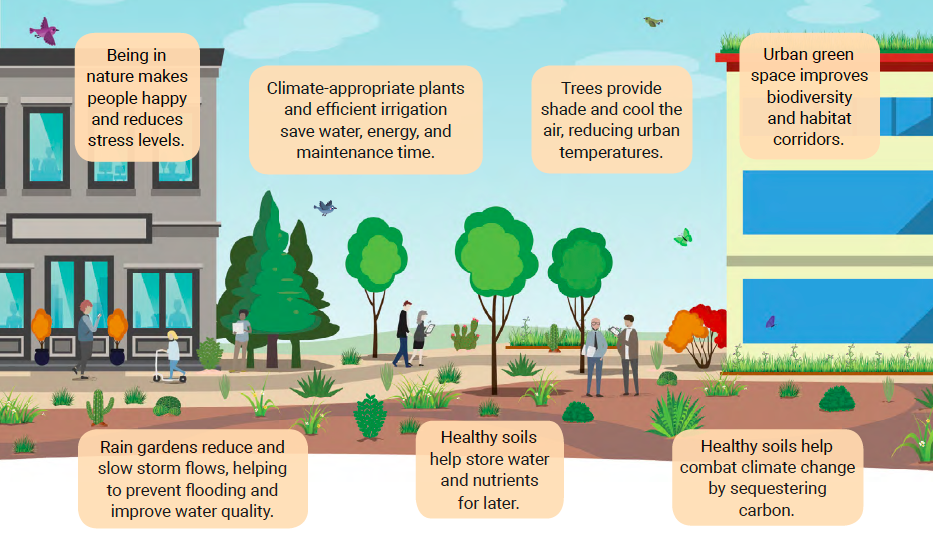By Cora Kammeyer and Sonali Abraham
The Pacific Institute has developed an interactive guide, Sustainable Landscapes in California: A Guidebook for Commercial and Industrial Site Managers, which provides step-by-step help for businesses interested in sustainable landscapes.
Through Sustainable Landscapes, We Can Improve the Resilience of Our Cities
Extreme weather, exacerbated by climate change, manifests through water – storms, floods, and droughts. Adapting to these new extremes will require rethinking water management, including the way we design urban areas to interact with water.
Currently, most of California’s cities are marked by vast expanses of turf and pavement, which are the opposite of drought and flood resilient. Half of all water used in California’s urban areas—more than four million acre-feet annually—is used outdoors, largely to irrigate turf grass. Vast paved areas like parking lots, walkways, and streets contribute to local flooding and water pollution because there is nowhere for stormwater to go. Sustainable landscapes provide an excellent alternative; replacing lawns with climate-appropriate landscapes that are irrigated efficiently can save water and reduce vulnerability to drought, and creating rain gardens with healthy soils can help stormwater soak into the ground and reduce flooding.
Businesses Will Play an Instrumental Role in Transitioning to Sustainable Landscapes
The scope and scale of our sustainability challenges warrants action by all Californians, including the business community. Commercial and industrial properties are disproportionately landscaped with turf grass and have large paved areas. Yet, most sustainable landscape programs have focused on residential properties.

Businesses can support their communities and improve management of local resources, including water, through investments in sustainable landscaping at their sites. Increasingly, businesses are adopting water stewardship programs that reduce their costs while providing benefits to communities and supporting public water policy goals where their facilities are located. Sustainable landscapes can be an important aspect of a business’s water stewardship commitment.
New Guidebook Provides Practical, Step-by-Step Guidance on Landscape Transformation for Businesses
There has been a lack of resources for businesses on sustainable landscapes, in comparison to resources for residential yard transformation. While the basic tenets of sustainable landscapes are the same across all property types, the decision-making process, financing options, installation, and maintenance of sustainable landscapes are different for businesses than for homeowners.
To help fill this information gap, the Pacific Institute recently released a guidebook, Sustainable Landscapes in California: A Guidebook for Commercial and Industrial Site Managers. The guidebook is aimed at site managers of commercial and industrial properties who are interested in adopting sustainable landscape practices. The guidebook provides simple steps for considering, selecting, and installing sustainable landscape practices, along with interactive worksheets and pop-out boxes. It tackles project decision-making, information required, and questions to ask landscape professionals, and it points users to helpful resources where needed.
The guidebook provides simple steps for considering, selecting, and installing sustainable landscape practices.
Sustainable Landscapes Provide Many Benefits to People and the Environment
The multiple benefits provided by sustainable landscapes can improve cost-effectiveness and provide businesses with an opportunity to publicly demonstrate their commitment to the triple bottom line: people, planet, and profit.

Replacing lawns with climate-appropriate plants that are irrigated efficiently can save water and reduce vulnerability to drought. When integrated with bioswales, rain gardens, and other green infrastructure, these projects can boost local water supplies, reduce flooding, and improve water quality. These practices can also save energy, provide habitat, sequester carbon, improve air quality, and increase resilience to climate change. They can make workplaces more enjoyable for employees, and neighborhoods more livable for communities.
Sustainable landscapes also provide direct benefits to a business. Those benefits can include:

Cost savings: Sustainable landscape practices can help save businesses money. This could include lower water bills, lower landscape maintenance costs, and even lower energy bills.

Meeting sustainability goals: A growing number of businesses have adopted sustainability goals such as reducing water use, waste, and greenhouse gas emissions. Investing in sustainable landscapes can help companies achieve these goals.

Advancing green reputation: Converting to a sustainable landscape is a highly visible way for businesses to demonstrate their commitment to sustainability. Unlike investments in water and energy efficiency inside a building, sustainable landscapes are something that people can see and interact with.

Practicing social responsibility: Businesses are increasingly recognizing the water-related risks facing their business operations and their communities. Investing in a sustainable landscape is a way for businesses to make positive contributions by addressing water risks and improving community livability.
Explore the guidebook here.
Read more about the Pacific Institute’s work on sustainable landscapes here.
Learn more about the Pacific Institute’s work with businesses here.


